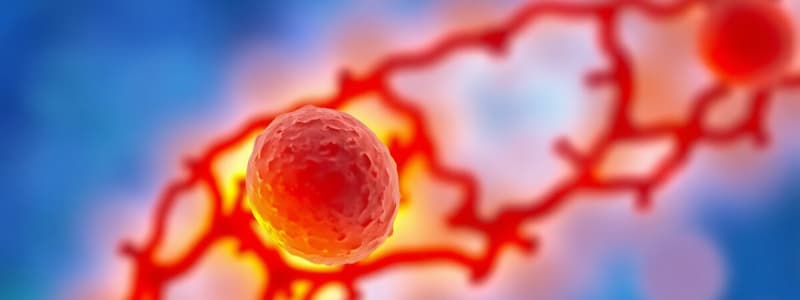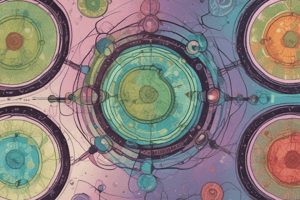Podcast
Questions and Answers
What is the primary purpose of the interphase in the cell cycle?
What is the primary purpose of the interphase in the cell cycle?
- To enable visible chromosome formation.
- To conduct mitosis and cytokinesis.
- To repair damaged DNA post-division.
- To prepare the cell for division through growth and DNA replication. (correct)
During which phase of the cell cycle does DNA replication primarily occur?
During which phase of the cell cycle does DNA replication primarily occur?
- S phase (correct)
- G2 phase
- M phase
- G1 phase
What role do checkpoints play in the cell cycle?
What role do checkpoints play in the cell cycle?
- To accelerate the transition between the M phase stages.
- To monitor DNA integrity and regulate progression through the cycle. (correct)
- To trigger uncontrolled cell division.
- To ensure cells are damaged and proceed further.
Which event occurs during anaphase in mitosis?
Which event occurs during anaphase in mitosis?
During which stage of mitosis do spindle fibers first begin to form?
During which stage of mitosis do spindle fibers first begin to form?
How does cytokinesis differ from mitosis?
How does cytokinesis differ from mitosis?
What initiates the cytoplasmic division during cytokinesis in animal cells?
What initiates the cytoplasmic division during cytokinesis in animal cells?
In which interphase phase does the cell primarily grow and synthesize proteins necessary for DNA replication?
In which interphase phase does the cell primarily grow and synthesize proteins necessary for DNA replication?
Flashcards
Cell Cycle
Cell Cycle
A series of events in a cell leading to its division and duplication, essential for growth, development, and repair.
Interphase
Interphase
The growth and preparation phase of the cell cycle, preceding cell division.It's NOT a resting phase.
Mitosis
Mitosis
The process of dividing the duplicated chromosomes into two new nuclei. Crucial for identical copies.
Prophase (Mitosis)
Prophase (Mitosis)
Signup and view all the flashcards
Metaphase (Mitosis)
Metaphase (Mitosis)
Signup and view all the flashcards
Anaphase (Mitosis)
Anaphase (Mitosis)
Signup and view all the flashcards
Telophase (Mitosis)
Telophase (Mitosis)
Signup and view all the flashcards
Cytokinesis
Cytokinesis
Signup and view all the flashcards
Study Notes
Cell Cycle Overview
- The cell cycle is a series of events that takes place in a cell leading to its division and duplication.
- It's a highly regulated process crucial for growth, development, and repair in multicellular organisms.
- The cycle is divided into two major phases: interphase and the mitotic (M) phase.
- Interphase is the period of growth and preparation for cell division.
- The M phase involves the actual division of the cell nucleus (mitosis) and the cytoplasm (cytokinesis).
Interphase
-
Interphase comprises the majority of the cell cycle.
-
It is not a resting phase but a period of intense activity.
-
Interphase is further divided into three distinct subphases: G1, S, and G2.
- G1 (Gap 1) phase: the cell grows in size and synthesizes proteins and other molecules necessary for DNA replication.
- S (Synthesis) phase: DNA replication occurs, ensuring that each daughter cell receives a complete set of genetic material. Crucially, the chromosomes are duplicated.
- G2 (Gap 2) phase: the cell continues to grow and produces proteins required for mitosis. Errors in DNA replication and other tasks are checked during this phase.
Mitosis
-
Mitosis is a complex process in which the duplicated chromosomes are divided equally into two new nuclei.
-
It is a precise process ensuring each daughter cell receives a complete and identical set of chromosomes.
-
Mitosis can be divided into distinct stages:
- Prophase: Chromatin condenses into visible chromosomes, each composed of two sister chromatids. The nuclear envelope begins to break down, and the spindle fibers start to form.
- Metaphase: Spindle fibers attach to the centromeres of the chromosomes. The chromosomes align along the metaphase plate (equator of the cell).
- Anaphase: Sister chromatids separate at the centromeres and move towards opposite poles of the cell, pulled by the spindle fibers.
- Telophase: Chromosomes reach the poles and begin to decondense. A new nuclear envelope forms around each set of chromosomes. Spindle fibers disassemble.
-
Cytokinesis: The cytoplasm divides, forming two separate daughter cells, each with a complete set of chromosomes and organelles.
Regulation of the Cell Cycle
-
The cell cycle is tightly regulated by checkpoints that monitor the integrity of DNA and the overall status of the cell.
-
These checkpoints ensure proper progression through the different stages and prevent the initiation of damaged cells.
- G1 checkpoint ensures cell size, nutrients, and growth factor signals are adequate.
- G2 checkpoint controls whether DNA synthesis was completed correctly, assuring proper progression to mitosis.
- M checkpoint assesses whether chromosomes are correctly attached to the spindle fibers.
Cell Cycle and Cancer
- Disruptions or deregulation of the cell cycle can lead to uncontrolled cell growth and division, a hallmark of cancer.
- Mutations in genes that regulate the cell cycle can lead to faulty checkpoints and uncontrolled growth, thereby contributing to cancer development.
Studying That Suits You
Use AI to generate personalized quizzes and flashcards to suit your learning preferences.




